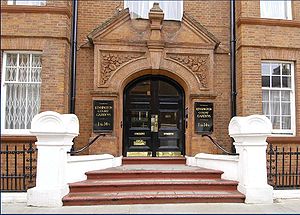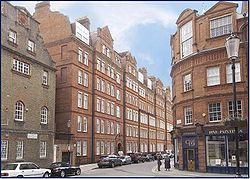
Kensington Court Gardens
Encyclopedia

Victorian architecture
The term Victorian architecture refers collectively to several architectural styles employed predominantly during the middle and late 19th century. The period that it indicates may slightly overlap the actual reign, 20 June 1837 – 22 January 1901, of Queen Victoria. This represents the British and...
mansion block, completed in 1889, near to Kensington Palace
Kensington Palace
Kensington Palace is a royal residence set in Kensington Gardens in the Royal Borough of Kensington and Chelsea in London, England. It has been a residence of the British Royal Family since the 17th century and is the official London residence of the Duke and Duchess of Cambridge, the Duke and...
and Gardens. Despite its plain, red brick exterior, it has been home to one of the greatest poets of the 20th century.
It is most famously the residence of poet, critic and playwright, T. S. Eliot
T. S. Eliot
Thomas Stearns "T. S." Eliot OM was a playwright, literary critic, and arguably the most important English-language poet of the 20th century. Although he was born an American he moved to the United Kingdom in 1914 and was naturalised as a British subject in 1927 at age 39.The poem that made his...
who moved to No.3 Kensington Court Gardens in 1957, after his secret marriage to his secretary from Faber and Faber
Faber and Faber
Faber and Faber Limited, often abbreviated to Faber, is an independent publishing house in the UK, notable in particular for publishing a great deal of poetry and for its former editor T. S. Eliot. Faber has a rich tradition of publishing a wide range of fiction, non fiction, drama, film and music...
, (Esmé) Valerie Fletcher
Valerie Eliot
Valerie Eliot née Esmé Valerie Fletcher is the surviving widow and second wife of the Nobel prize-winning poet, T. S. Eliot...
on January 10, 1957. The marriage was criticised not only because it was kept a secret from all but her parents, but at the time Eliot was 68 and Valerie only 30 years old.
Despite the criticism and the age difference, it appears to have been the happiest time of Eliot’s life, the Oxford Dictionary of Biography stating he “attained a degree of contentedness that had eluded him all his life”.
However, at the time Eliot’s health was already in decline and he died in the flat only eight years later, on January 4, 1965. Mrs Valerie Eliot still lives at No.3 Kensington Court Gardens and is editor and guardian over his letters, many of which are still un-published. Further notable residents include the Kopman family, who amassed their fortune in the property development and investment banking arenas.
The location of today’s Kensington Court Place was formerly part of the Vallotton estate, dating back to the late 18th century. Kensington Court Place was originally known as Charles Street and renamed in 1908. The eastern side of Charles Street was the former site of open grounds, known as The Paddock. It was the home of the Kensington Lawn Tennis Club prior to being bought by local surveyor, Albert James Barker for building development in 1886.

The Times
The Times
The Times is a British daily national newspaper, first published in London in 1785 under the title The Daily Universal Register . The Times and its sister paper The Sunday Times are published by Times Newspapers Limited, a subsidiary since 1981 of News International...
first advertised flats for Kensington Court Gardens in January 1889 at between £195 and £250 per annum. Kensington Court Gardens first appears in the London Directory in 1889, listed with Moir Wallis & Co. Builders, with building works not completed. The first residents appear in the 1890 Directory, with flat No.1 again, with Moir Wallis & Co. Interestingly, during the 1890s a number of residents of Kensington Court Gardens are retired military men.
The 1891 census shows residents General Alexander Silver, Lieutenant-Colonel Arnold Knight and Major-General James Black. The 1901 census and Royal Blue Book show other notable residents, including the builder Frederick Moir at No.7 and publisher Herbert Doubleday at No.9. Doubleday was responsible for the publishing of the Victoria History of the Counties of England and The Complete Peerage. Flat No.1 Kensington Court Gardens was originally the home of the building caretaker, listed in the 1891 census as Mr Charles Hall with his wife Emily. The 1901 census shows No.1 as the home of James E. Raybould, Hall Porter, with his wife Elizabeth.

